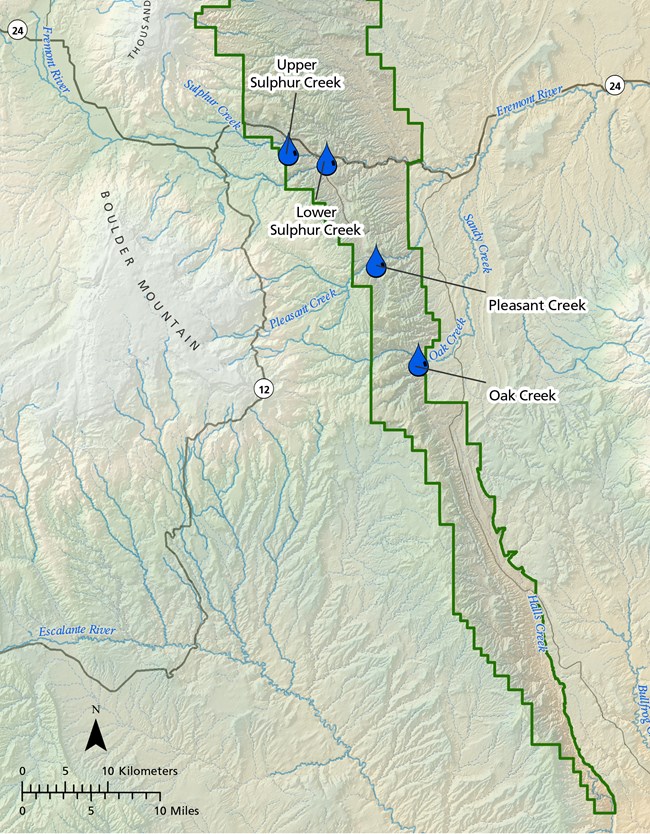Last updated: November 15, 2021
Article
Monitoring Bacterial Contamination in Streams at Capitol Reef National Park

Splashing around in the water is a great way to cool off on a hot summer day. At Capitol Reef National Park, hiking along Sulphur Creek is a popular summer activity—in part because most of the hike involves wading through the creek. In a couple places, the water is deep enough for swimming.
But how do you know the water is safe for swimming?

Background
It might come as a surprise to learn that even national-park waters are not always pristine. But in 2014, the State of Utah listed the segment of the Fremont River that flows through Capitol Reef National Park as impaired for Escherichia coli. E. coli are fecal bacteria found in waste of humans, livestock, and wildlife. Some kinds of E. coli can cause diarrhea, urinary tract infections, pneumonia, and other illnesses. These bacteria can also signal the potential for other waste-borne pathogens.
The Utah Division of Water Quality is developing a plan to reduce E. coli concentrations in the Fremont River. Recent sampling results collected by the Northern Colorado Plateau Network (NCPN) are helping the State to determine possible sources of E. coli contamination in the river segment that flows through Capitol Reef National Park.
The NCPN monitors water quality in 11 different National Park Service units, including Capitol Reef National Park. Once a month, network staff collects samples at four locations that drain into the Fremont River: Pleasant Creek, Oak Creek, and two sites on Sulphur Creek. The samples are analyzed for many different water-quality indicators. Overall, water quality at Capitol Reef National Park has been found to be good since monitoring began in 2008.

Findings
But from 2008 to 2017, NCPN sampling revealed the following about E. coli in Fremont River tributaries of Capitol Reef National Park:
—Most of the time, E. coli levels were low at all four monitoring sites. But there were occasions when E. coli concentrations exceeded state water-quality standards for recreational use.
—Most exceedances occurred during the state-defined recreation season of May 1–October 31, when most visitation occurs.
—High E. coli concentrations were found even during conditions of low flow and relatively clear water, suggesting that E. coli contamination is not just due to flood events.
—Sulphur Creek samples taken both upstream and downstream of a popular hiking area and the park’s developed area showed similar patterns in E. coli concentrations. This suggests that most E. coli contamination in Sulphur Creek enters upstream of the park, rather than coming from visitors or park infrastructure.

Conclusions
Possible sources of E. coli contamination include livestock, wildlife, and humans. Humans can contribute to contamination either indirectly, through faulty septic systems, or directly—by relieving themselves too near the stream or otherwise failing to properly dispose of bodily waste. But despite frequent hiker use of Sulphur Creek, we did not observe chronic increases in E. coli concentrations or more frequent exceedances of water-quality standards downstream of the hiker-use area. Livestock grazing and light recreation use occur on public lands upstream of the park. The park permits local ranchers to trail cattle through the park along Oak Creek and Pleasant Creek at designated times during the year. Trespass cattle have been noted in Oak Creek outside the permitted time for cattle trailing. Reliable methods to distinguish between livestock and wildlife sources are still in development.
Northern Colorado Plateau Network staff will continue to sample for E. coli. We will report high bacteria levels to park managers, who will keep the public informed of the importance of good water quality and the risks associated with recreating in waters where E. coli standards are not being met.
Information presented here was summarized from C. Hackbarth and R. Weissinger. 2018. Escherichia coli Concentrations in Fremont River Tributaries at Capitol Reef National Park, 2008–2017. Natural Resource Report NPS/NCPN/ NRR—2018/1698. National Park Service, Fort Collins, Colorado.
